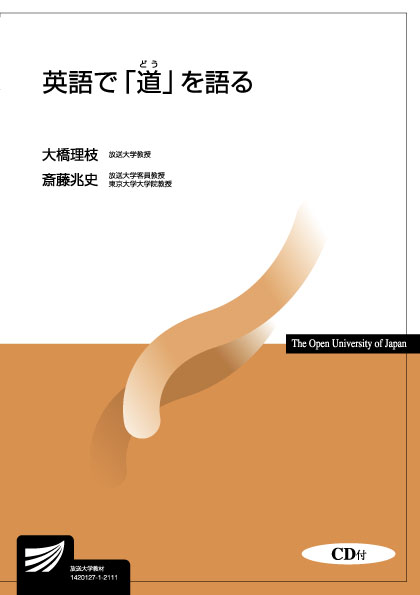
Title
Eigo de Do wo kataru (Discussing Dō in English)
Size
208 pages, A5 format, attached CD-rom
Language
Japanese
Released
March, 2021
ISBN
978-4-595-32290-7
Published by
Foundation for the Promotion of The Open University of Japan
Book Info
See Book Availability at Library
Japanese Page
This is primarily a textbook for the language course ‘Eigo de dō wo kataru’ [Discussing Dō in English] (2021- ) offered by the Open University of Japan. It also aims to provide the general reading public with basic materials and insights for examining, discussing (especially in English), and finally understanding the Japanese idea of dō (pronounced like ‘doh’ represented by the Chinese character 道 that literally means ‘way’ or ‘road’, and quite often translated as ‘Way’ with a capital W) as one of the key elements that affect and sometimes determine the way Japanese people speak (or even stay silent) and behave as they do in seemingly symbolic and formalistic manners. This idea, however, has rarely been discussed as one semantic entity; it has only been described and understood separately in, and more often nonverbally conveyed through such physical, artistic, ethical and religious arts and disciplines as judo, kyudo, kendo, aikido, all of which are generally categorized in budo (martial arts), sado (the tea ceremony), shodo (Japanese brush calligraphy), butsudo (the Way of Buddha) and many other dō arts and disciplines.
This textbook, therefore, inevitably takes the inductive method of first taking a look at individual dō arts and disciplines and then discussing the essence of dō which will be extracted from them. Lesson 1 introduces the general topic of the whole course, and the next two lessons respectively deal with the tea ceremony and Japanese brush calligraphy. After reviewing in Lesson 4 the language materials (especially grammar and vocabulary) used in the first three lessons, the textbook goes on to describe and explain specific dō arts and disciplines in Lessons 5 and 6, this time budo (martial arts) and butsudo (the Way of Buddha), reviewing in Lesson 7 the language materials used in those two lessons.
The latter half of the textbook takes a look at dō with special attention to those features that are widely observed across them—formalism (Lesson 8), symbolism (Lesson 9), narrativity (Lesson 11), and paradox (Lesson 12)—and language materials used in them (Lessons 10 and 13). Lesson 14 discusses how difficult it may possibly be for foreign people to understand the philosophy underlying dō activities, which can sometimes seem to be instilling idealized qualities in men or women or functioning as a surrogate form of piety for Japanese people who lack religious faith. The last lesson (Lesson 15), after reviewing the language materials used in the previous two lessons, concludes the whole discussion throughout the book by encouraging the reader/learner to define dō in their own terms.
(Written by SAITO Yoshifumi, Professor, Graduate School of Education / 2021)
Table of Contents
Lesson 2 The Tea Ceremony
Lesson 3 Brush Calligraphy
Lesson 4 Review 1
Lesson 5 Martial Arts
Lesson 6 The Way of Buddha
Lesson 7 Review 2
Lesson 8 Formalism
Lesson 9 Symbolism
Lesson 10 Review 3
Lesson 11 Narrativity
Lesson 12 Paradox
Lesson 13 Review 4
Lesson 14 Dō Seen from Overseas
Lesson 15 What is Dō?
Related Info
The Open University of Japan “Discussing Dō in English [’21]” (The Open University of Japan YouTube channel 2021)
https://www.youtube.com/watch?v=FqAZt508a3k



 Find a book
Find a book

